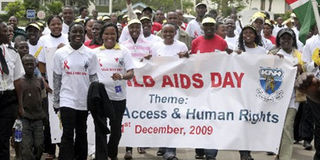Aids takes heavy toll on learning

Photo | FILE
An Aids Day march in Nairobi in 2010
Public schools are having to deal with heavier teacher workloads as some staff members die from complications related to HIV/Aids while others remain absent from classrooms for long due to ailments.
According to a new report, the schools, which are already suffering a shortage of teaching and learning materials, are also having an added load of managing some of the 2.4 million orphans and vulnerable children, who are of school-going age, following the death of their parents and caregivers.
Some of the pupils enrolled in schools may be mourning the loss of their parents, facing stigma and discrimination while others are living in poverty, according to the HIV/Aids in Kenya: Its impact on education and an analysis of the implementation of the Kenyan education sector’s HIV/Aids policy report.
According to the report — which was compiled jointly with the United Nations Educational, Scientific and Cultural Organisation — hundreds of teachers are either dying from conditions associated with HIV/Aids or are having to be absent from school as they battle with ailments.
As of 2010, there were 192,421 registered primary school teachers and 66,037 registered secondary teachers.
National statistics on attrition among serving teachers provided by the Teachers Service Commission’s pensions department revealed that total teacher attrition over the 16-year period up to 2010 was at least 91,350.
This represents an average of 5,800 teachers leaving through deaths, retirement, sacking and resignation.
However, the commission’s statistics masked information on the cause of death or the reason for retirement and resignation for each of the cases.
Morale reduced
The report said it may be assumed that some deaths were HIV-related. Last year alone, 97 deaths, 492 retirements and 37 resignations were recorded in the first four months.
The report terms as high the rates of teacher attrition and absenteeism. Some teachers had their morale reduced due to stigma, discrimination and fatigue.
“There are high stress levels as extra burden falls on administrators and other school staff,” the report said. “The net result is deterioration of the learning environment and lower achievement levels.”
The study suggested that efforts be made to reduce the effects of deaths on the education sector staff. This will reduce absenteeism by teachers, improve teaching and learning, and reduce costs of running education programmes.
It will improve the enrolment rates, school attendance and completion rates of pupils affected or infected by HIV/Aids. There should also be deliberate moves to reduce stigma and fear, and improve the psycho-social state of affected learners and staff.
Other children, the report says, are suffering from malnourishment while others are acting as caregivers at their homes where they head households.
“Unless measures are taken, affected learners may have lower levels of schooling and progress more slowly through school than their non-affected counterparts,” the report said.
According to the report, girls and young women tend to be more affected by the epidemic since they may be required to act as caregivers or be denied the chance to go to school in favour of boys when household resources are scarce.
Although there have been some additional interventions following the implementation of the Education Sector Policy on HIV/Aids, the magnitude of the impact of these activities is largely unknown.
Although there has been a reduction in stigma and discrimination in schools, the report says, teachers were still reluctant to disclose their status.
Feeding programmes
It notes that school feeding programmes targeting orphaned and vulnerable children in Kenya have resulted in positive nutritional and schooling outcomes.
“School feeding programmes, if not accompanied by an appropriate learning environment and family or community support, are insufficient to achieve the objective of developing healthy, educated children,” the report says.
The school feeding programme must take better account of social, economic and cultural constraints. Other programmes that have contributed to enrolment and retention are conditional cash transfers and provision of resources to meet schooling needs.
The report recommends the government to make efforts to address staff mortality through early identification of health problems, including HIV, and the provision of treatment to staff.
“In addition to this being cost-effective,” the report says, “it would contribute to continuity in service delivery and relieve some of the stress placed on school staff due to absenteeism and illness”.
It attributes absenteeism of teachers, managers and support staff from schools to stigma and discrimination or sickness of household members.
It says most people’s reaction to those affected by HIV/Aids was stigma and discrimination due to inadequate knowledge about the causes of the condition.
Others reacted with superstition and fear. “There remains an air of secrecy surrounding the epidemic,” the report says.
“In many educational institutions, there is speculation concerning people’s HIV status.” The stigma and fear inhibited access to voluntary counselling and testing.
For example, there were instances where headteachers did not know which teachers were HIV-positive and which children were affected by HIV/Aids.
In such cases, staff and students who might lend support to those affected cannot do so. There are also issues of privacy and sensitivity.




